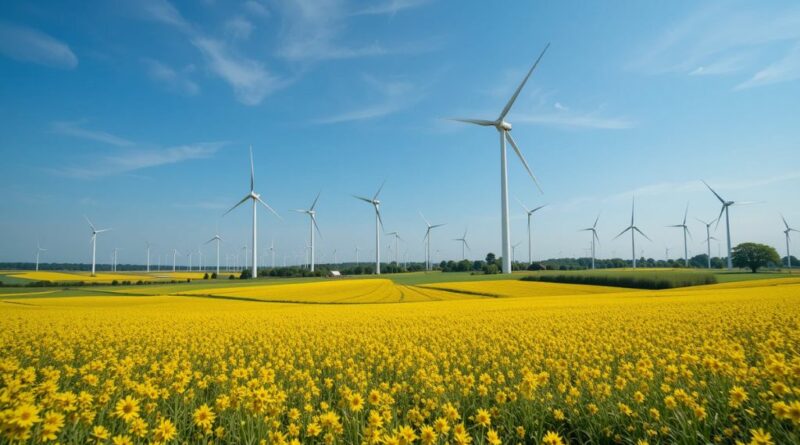Seven Nations Leading the Renewable Electricity Revolution
Article courtesy: SoftpageCMS.com
In an era of climate urgency, seven nations have achieved what many consider the holy grail of energy transition: electricity grids powered almost entirely by renewable resources. While the global average for renewable electricity generation hovers around 29%, according to the International Energy Agency, Albania, Bhutan, Nepal, Paraguay, Iceland, Ethiopia, and the Democratic Republic of the Congo have pushed well beyond this frontier, demonstrating that 100% renewable electricity generation is not merely theoretical but achievable today.
The Hydro-Powered Pioneers
The backbone of these renewable achievements is predominantly hydroelectric power, though each country presents unique characteristics worth examining.
Paraguay: South America’s Clean Energy Powerhouse
Paraguay stands as perhaps the world’s most remarkable renewable electricity success story. Not only does the country generate 100% of its electricity from renewable sources, but it produces far more than it consumes. The Itaipu Dam, a massive joint venture with neighbouring Brazil on the Paraná River, is one of the world’s largest hydroelectric facilities, generating approximately 103.1 TWh annually.
“Paraguay produces about 60 TWh of electricity annually but consumes only about 15 TWh, making it the world’s largest net exporter of clean electricity,” explains Dr. Fernando Masi of the Centre for Analysis and Diffusion of the Paraguayan Economy.
Bhutan: Carbon-Negative Nation
The Himalayan kingdom of Bhutan has built its electricity system almost exclusively on hydropower, with plants strategically positioned to harness the power of fast-flowing mountain rivers. According to the Royal Government of Bhutan, the country generates approximately 2,335 MW of hydroelectric power, not only meeting domestic needs but exporting surplus electricity to India.
Bhutan’s achievement extends beyond renewable electricity—it’s one of the world’s few carbon-negative countries, absorbing more carbon than it emits through its extensive forest coverage and committed environmental policies.
Nepal: Harnessing Himalayan Waters
Neighbouring Nepal has similarly capitalised on its mountainous geography to develop hydroelectric resources. The country has installed capacity of approximately 2,000 MW of hydropower, according to the Nepal Electricity Authority, with ambitious plans to increase this capacity to 15,000 MW by 2030.
Albania: Mediterranean Hydro Leader
Albania’s electricity system relies almost entirely on hydropower plants along its rivers, including the Drin River cascade system. The Albanian Energy Regulatory Authority reports that hydropower accounts for over 95% of domestic electricity production, though in drought years, the country sometimes must import electricity.
Democratic Republic of Congo: Untapped Potential
The DRC generates nearly all its electricity from the massive Inga hydroelectric plants on the Congo River, with current capacity around 1,775 MW. However, the country faces significant challenges in distribution and access—despite almost 100% renewable generation, only about 20% of the population has reliable electricity access, highlighting that renewable achievement doesn’t automatically solve all energy challenges.
Ethiopia: Africa’s Hydro Champion
Ethiopia has invested heavily in hydroelectric development, with the Grand Ethiopian Renaissance Dam (GERD) representing Africa’s largest hydropower project. When fully operational, GERD will add 6,450 MW to Ethiopia’s generating capacity, according to the Ethiopian Electric Power corporation. Like the DRC, Ethiopia’s challenge isn’t renewable percentage but extending access to its large rural population.
Beyond Hydro: Iceland’s Diverse Renewable Portfolio
Uniquely among these seven nations, Iceland has developed a diverse renewable portfolio that doesn’t rely exclusively on hydropower.
“Iceland’s electricity comes approximately 73% from hydropower and 27% from geothermal sources,” notes Dr. María Guðmundsdóttir of the University of Iceland’s Institute of Earth Sciences. “This geothermal component represents one of the highest percentages worldwide and demonstrates how countries can leverage their unique geological assets.”
Iceland’s National Energy Authority reports that this diverse approach provides remarkable stability in the country’s renewable generation.
Challenges and Limitations
The achievements of these seven nations, while impressive, come with important context that affects their replicability:
Geographic Advantages
All seven countries possess exceptional natural resources for renewable generation—whether abundant rainfall and elevation changes for hydropower or Iceland’s unique position on a geothermal hotspot.
“These countries have capitalised on extraordinary geographic circumstances,” explains Professor Amanda Johnson of the Centre for Global Energy Studies. “Their achievements demonstrate what’s possible under optimal conditions, but they don’t necessarily provide a direct blueprint for nations with different geographical characteristics.”
Population and Development Factors
Several of these countries combine relatively small populations with significant renewable resources. Bhutan (population 775,000) and Iceland (population 370,000) can meet their needs with fewer large-scale installations than would be required for more populous nations.
Intermittency and Seasonal Variations
Even these renewable champions face challenges with resource variability. Albania and Nepal occasionally import electricity during drought seasons when hydropower production declines. Without substantial energy storage systems, 100% renewable grids must manage seasonal fluctuations carefully.
Grid Stability Considerations
Hydropower, unlike wind and solar, provides consistent baseload power, making grid management simpler than it would be with higher percentages of intermittent renewables. As the International Hydropower Association notes, hydro plants can quickly adjust output to match demand fluctuations, providing stability services that other renewables cannot always deliver.
Diversification Efforts
Recognising the risks of over-reliance on single energy sources, several of these countries are actively diversifying their renewable portfolios:
- Bhutan is developing solar capacities to complement hydropower and mitigate drought vulnerability
- Nepal has begun implementing wind projects in its western regions
- Albania is exploring significant solar potential along its Mediterranean coastline
- Iceland continues to research enhanced geothermal technologies to increase efficiency
Lessons for Other Nations
While the specific circumstances of these seven countries cannot be perfectly replicated elsewhere, their experiences offer valuable insights:
1. Assess and Maximise Natural Resources
Each country has succeeded by identifying and developing its most abundant natural resources first. Nations beginning renewable transitions should similarly prioritise their strongest natural advantages, whether solar in sun-rich regions or offshore wind for coastal countries.
2. Regional Integration Benefits
Paraguay’s experience demonstrates how regional electricity markets can support renewable development by providing export options for surplus generation. The European Network of Transmission System Operators similarly advocates for increased cross-border grid connections to support renewable integration.
3. Long-Term Vision Required
Several of these nations, particularly Bhutan and Iceland, made deliberate policy choices decades ago to prioritise renewable development. The International Renewable Energy Agency emphasises that successful transitions require sustained policy commitment across multiple government terms.
4. Beyond Generation: Access Matters
The experiences of Ethiopia and the DRC highlight that generating renewable electricity is only part of the energy challenge. Developing robust distribution infrastructure and ensuring universal access remains essential for realising the full benefits of clean energy.
Moving Forward: The Global Context
As the world seeks to limit global warming to 1.5°C above pre-industrial levels, these seven nations demonstrate that 100% renewable electricity generation is achievable. However, most countries will require a broader mix of renewables and significant investments in grid infrastructure and storage technologies.
“The transition to renewable electricity is technical and economical,” concludes Professor Johnson. “These seven nations prove it can be done, but each country must chart its path based on its unique resources, needs, and capabilities.”
With global renewable capacity growing at unprecedented rates and costs continuing to fall—Bloomberg New Energy Finance reports that solar and wind are now the cheapest forms of new electricity in countries representing two-thirds of the world population—more nations may soon join this pioneering group of renewable electricity leaders.
We’d love your questions or comments on today’s topic!
For more articles like this one, click here.
Thought for the day:
“Love and compassion are necessities, not luxuries. Without them humanity cannot survive.” Dalai Lama



